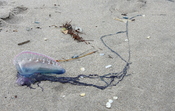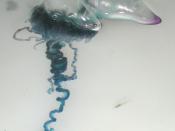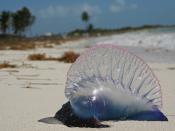The Portuguese man-of-war if a member of the Kingdom Animalia, phylum Cnidaria(1), class Hydrozoa, order Siphonophra, the genus Physalia, and the species Physalia(2).
The man-of-war is not an actual jellyfish, but a Siphonophor. Also the man-of-war is not a single organism. It is made up of many different organisms that work together. These organisms are called polyps.
The Portuguese man-of-war is usually found in the Northern Atlantic gulf stream. It can also be found in the tropical and subtropical regions of the Indian and Pacific Oceans.
The man-of-war will usually travel in groups, that may contain up to one thousand members.
The main portion of the man-of-war's body is an oblong gas-filled bladder. The bladder is usually nine to thirty centimeters long, and is a translucent pink, blue, or purple. On top of the bladder is a crest. This is to catch the wind, and move the man-of-war along. Below the bladder, hang long stringy tentacles, that can reach a length of up to fifty meters.
The tentacles are made-up of three different types of polyps. The names of these three polyps are: dactylozooid, gonozooid, and gastrozooid. The polyps are the parts that: capture prey, digest prey, and reproduce. The dactylozooids have cells called nematocysts(3). The nematocysts release a toxin(4) into anything that they come into contact with. The gastrozooids then attach to the dead/stunned victim, and spread over it. They digest it, and transfer food to the rest of the man-of-war. Last, the gonozooids create other polyps. The means by which the man-of-war reproduces, however, is not yet understood.
The fish Nomeus gronvii lives among the tentacles of the man-of-war. This fish, which is eight centimeters long, is mostly immune to the man-of-war's toxin. It will eat the tentacles, which will grow back, as its main source of food.


